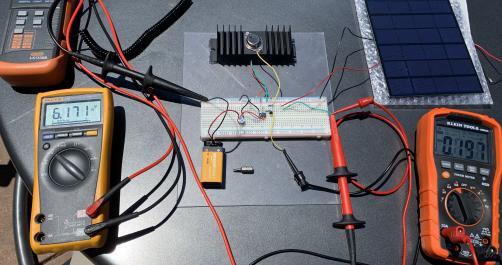Cal Energy Corps interns have been hard at work both in-person and remotely with their host organizations! As the 2021 program draws to a close, they have officially wrapped up their projects and tasks. Let’s take one last look at the work some of our interns accomplished.
Over the summer, hardware engineer intern Naveen Bahadur has been working in-person at the Gridware office in Walnut Creek. After ordering sample solar panels, he was able to build a circuit to test variations in solar irradiance, a major concern with using solar energy. Luckily, he was able to spend some time outside to conduct his experiments: “I was able to finish almost all of the outdoor testing that I wanted to get done, which meant generating around 40 curves that display the performance of the panels under various conditions.
Testing all of the panels under these two shading conditions revealed some interesting discoveries. Most of the panels barely produced any power when half shaded either way, but two of the panels were still able to output around 1.7W when the bottom half was shaded— which is still about half of their rated power. This data allows me to declare with very high certainty that the cells in those two panels are strung together horizontally in series and vertically in parallel, meaning they would outperform the other panels when exposed to foliage that obstructs the panel horizontally.”
With Johnson Controls, product manager intern Christabella Annalicia was tasked with two projects at the start of summer: creating a database for the OpenBlue Central Utility Plant and simulating savings for specific scenarios. In addition to these two, she has also been working on several customer projects: “I am tasked to help calibrate the existing project model on Plant Simulator such that there will be improvements in baseline simulation results. This is due to the fact that prior baseline simulations generated numbers that were off from measured results, the most optimal of which is the plant efficiency in kilowatts per ton (kW/ton). Simply put, the simulation results did not match the measured annual results. Therefore, this created the need for new baseline models and simulations such that we can get a number much closer to the typical chiller plant efficiency. In addition, from measured trend data and from additional analyses, it is much more plausible to have a number closer to the typical chiller plant efficiency range rather than having a super efficient number.”
Through her internship, she has learned that “it is mind-opening to understand the need for more efficient and green buildings today, especially as the effects of climate change are starting to heighten to their full (frightening) potential. According to the Environmental and Energy Study Institute (EESI), buildings account for almost 40 percent of US carbon dioxide (CO2) emissions. With this knowledge, in addition to knowing that there is an urgent need for aggressive measures in order to reach our climate goals, climate change mitigation strategies must take into consideration the carbon emissions contributed by buildings; any holistic strategy must also be able to propose improvements to existing buildings in order to make them more sustainable and green. As someone who has never been exposed to the work being done in this area of green and sustainable buildings, it is interesting to learn that improvements (regardless of how small or big) done to the places we live, work, and play in can have large impacts on the environment we interact with.”
Read more about the interns’ experiences and final reflections in their blogs on the Cal Energy Corps website!

